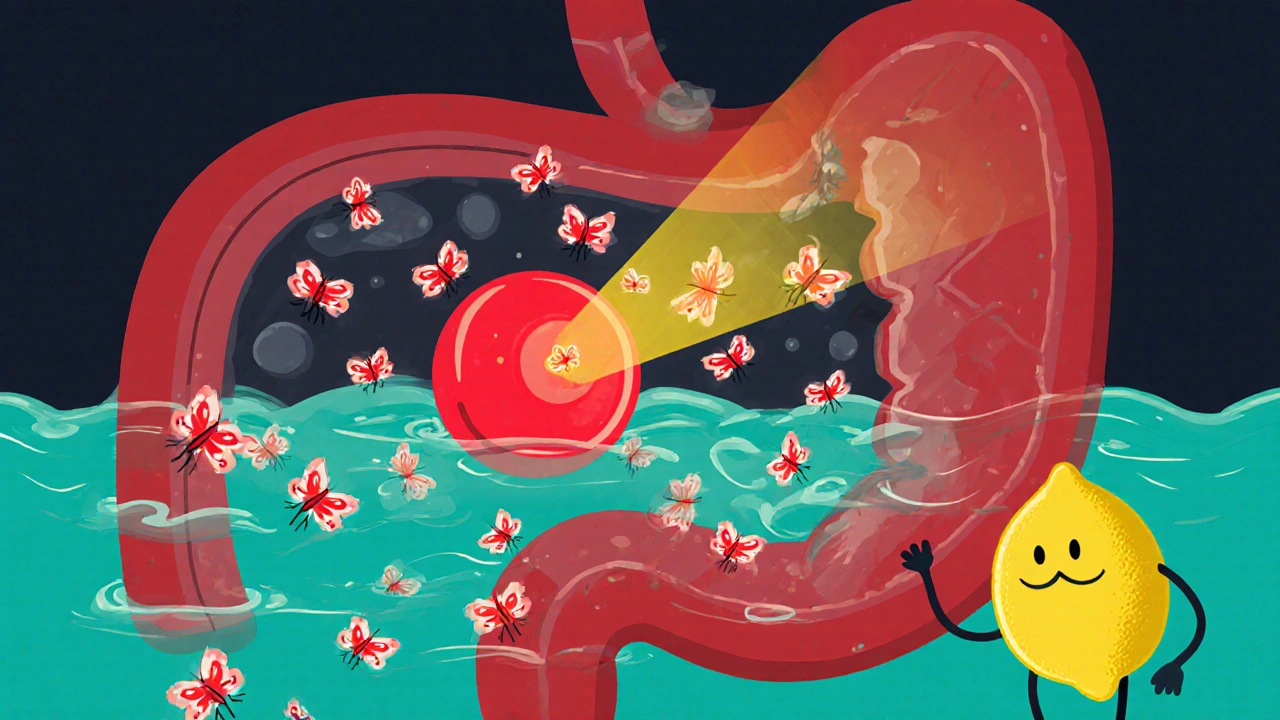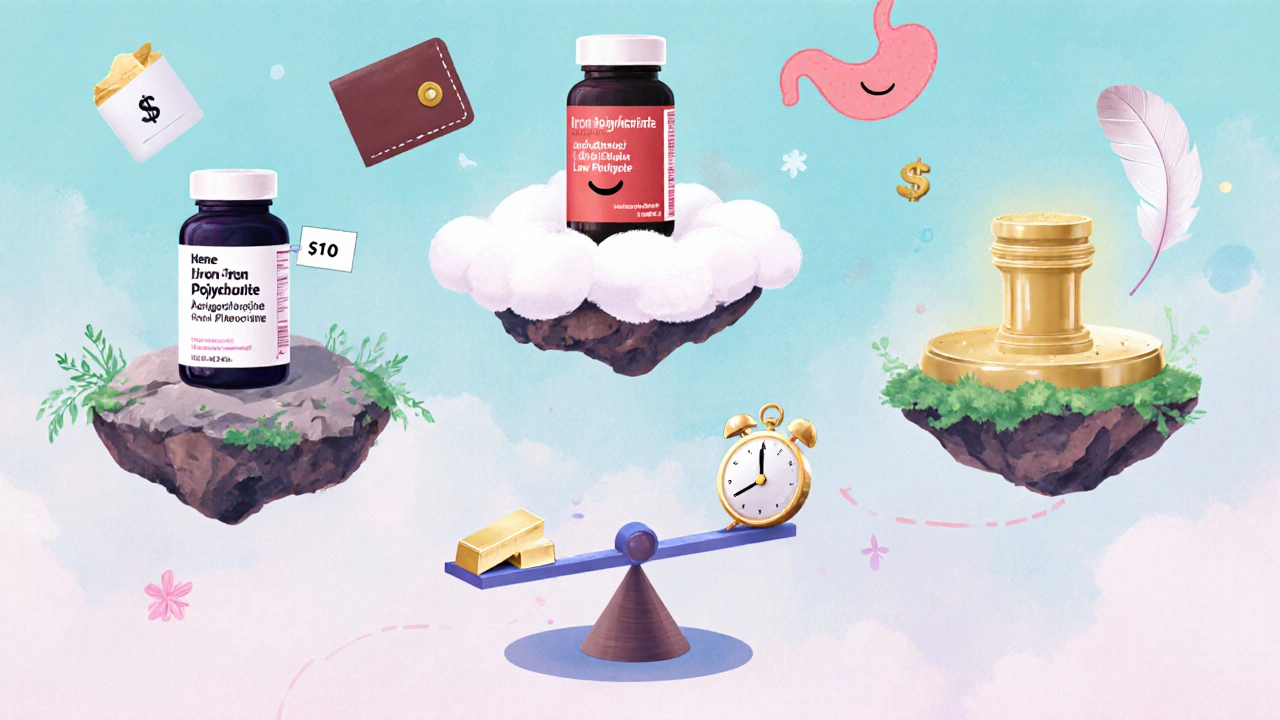Iron Supplement Comparison Calculator
Personalized Iron Supplement Guide
Answer these 3 questions to find your ideal iron supplement match. This tool uses the latest clinical data to help you choose the right option for your health needs.
Iron deficiency affects millions of people worldwide, and choosing the right supplement can feel overwhelming. This guide breaks down the most popular forms of iron-starting with ferrous sulfate - and puts them side‑by‑side with common alternatives. By the end, you’ll know which option matches your health goals, budget, and tolerance.
What is Ferrous Sulfate?
Ferrous sulfate is a water‑soluble iron salt that has been used for over a century to treat iron‑deficiency anemia. Its chemical formula, FeSO₄·7H₂O, delivers about 20 % elemental iron per milligram of compound, making it one of the most potent over‑the‑counter options.
How Does Ferrous Sulfate Work?
When you swallow a tablet, stomach acid releases Fe²⁺ ions, which are then absorbed primarily in the duodenum. The body stores the iron in ferritin and uses it to make hemoglobin, the protein that carries oxygen in red blood cells. Because ferrous sulfate provides a high dose of elemental iron, it can replenish depleted stores quickly-often within weeks.
Common Alternatives
Not everyone tolerates ferrous sulfate well. The most frequently recommended substitutes are:
- Ferrous gluconate - a milder iron salt that supplies roughly 12 % elemental iron. It’s often chosen for people who experience stomach upset on sulfate.
- Ferrous fumarate - offers about 33 % elemental iron, more than sulfate, but is still well‑absorbed.
- Iron bisglycinate - a chelated form where iron is bound to two glycine molecules. This design protects iron from stomach acid, reducing gastrointestinal side effects while maintaining good absorption.
- Heme iron polypeptide - derived from animal hemoglobin. It bypasses the usual non‑heme absorption pathway, delivering up to 30 % higher bioavailability.
Other nutrients, like Vitamin C, aren’t iron sources themselves but dramatically boost the uptake of non‑heme iron by converting Fe³⁺ to the more absorbable Fe²⁺ form.

Side‑By‑Side Comparison
| Form | Elemental Iron % | Typical Dose (mg elemental) | Absorption Rate* | Common Side Effects | Cost (USD per 30‑day supply) |
|---|---|---|---|---|---|
| Ferrous sulfate | 20 % | 325 mg (≈65 mg elemental) | ~10 % | Stomach irritation, constipation, dark stools | $8‑$12 |
| Ferrous gluconate | 12 % | 300 mg (≈36 mg elemental) | ~8 % | Less irritation, mild nausea | $10‑$14 |
| Ferrous fumarate | 33 % | 200 mg (≈66 mg elemental) | ~12 % | Similar to sulfate but slightly better tolerance | $9‑$13 |
| Iron bisglycinate | 20 % | 25 mg elemental (often 1‑2 tablets) | ~15‑20 % (chelated) | Very low GI upset, good for sensitive stomachs | $15‑$22 |
| Heme iron polypeptide | 30 % | 12 mg elemental (typically 1‑2 capsules) | ~30 % (heme pathway) | Minimal GI issues, occasional metallic taste | $25‑$35 |
*Absorption rates are averages from clinical studies; individual results vary.
Choosing the Right Iron Supplement
Here are three simple questions to ask yourself before picking a product:
- How severe is your deficiency? If labs show a deep drop in ferritin, a high‑dose option like ferrous sulfate or ferrous fumarate may be needed for a short period.
- Do you have a sensitive stomach? Chelated forms such as iron bisglycinate or heme iron polypeptide are gentler and often preferred by people with IBS or ulcer disease.
- What’s your budget? Generic ferrous sulfate remains the most cost‑effective, while heme iron can cost three to four times more.
For most healthy adults with mild‑to‑moderate deficiency, starting with ferrous sulfate and adding a vitamin C source (like orange juice) works well. If GI distress becomes a problem, switch to iron bisglycinate before moving to the pricier heme option.

Practical Tips for Maximizing Absorption
- Take your iron supplement on an empty stomach, preferably 1 hour before meals or 2 hours after.
- Consume vitamin C‑rich foods or a small glass of citrus juice alongside the dose.
- Avoid calcium‑rich foods, tea, coffee, or high‑phytate grains at the same time-they can bind iron and reduce uptake.
- Split the total daily dose into two smaller servings if you experience constipation.
- Stay hydrated and include fiber‑rich vegetables to help prevent hard stools.
Potential Side Effects & Safety Considerations
Iron overload is rare but can happen if you exceed recommended doses for long periods. Watch for symptoms like joint pain, fatigue, or a bronze‑gray skin tone. Children should never take adult formulations without medical guidance, as accidental overdose can be fatal.
Common side effects differ by form:
- Ferrous sulfate: nausea, abdominal cramps, constipation, dark-colored stools.
- Ferrous gluconate: milder nausea, occasional diarrhea.
- Ferrous fumarate: similar to sulfate but slightly less constipation.
- Iron bisglycinate: minimal GI upset, occasional mild headache.
- Heme iron polypeptide: very low GI side effects, rare metallic aftertaste.
Always discuss supplementation with a healthcare professional, especially if you have conditions like hemochromatosis, inflammatory bowel disease, or are pregnant.
Frequently Asked Questions
Can I take ferrous sulfate and vitamin C together?
Yes. Vitamin C converts Fe³⁺ to Fe²⁺, which the gut absorbs more efficiently. A small glass of orange juice or a vitamin C tablet taken with the iron dose can boost absorption by up to 50 %.
Is iron bisglycinate as effective as ferrous sulfate?
Clinical trials show that iron bisglycinate delivers comparable increases in ferritin levels, but with far fewer gastrointestinal complaints. It’s a good choice when tolerance is a priority.
How long should I stay on an iron supplement?
Typically 3 - 6 months after blood levels normalize, then you can taper or switch to a maintenance dose. Ongoing monitoring with a doctor ensures you don’t overshoot.
Can I use a multivitamin instead of a dedicated iron pill?
Most over‑the‑counter multivitamins contain only 10‑18 mg elemental iron, which may be insufficient for moderate‑to‑severe deficiency. A targeted iron supplement ensures you get the dose needed to rebuild stores.
Are there any foods that interfere with iron absorption?
Yes. Calcium‑rich dairy, tea, coffee, and high‑phytate grains (like whole wheat or brown rice) can bind iron and lower uptake. Space them at least two hours apart from your supplement.
By weighing potency, tolerance, and price, you can pick the iron form that fits your lifestyle. Whether you stick with the classic ferrous sulfate or try a newer chelate, the right choice will get your hemoglobin back on track.


Rajesh Singh
Look, folks, the devil’s in the details when it comes to iron. Ferrous sulfate may be cheap, but its harsh stomach‑acid assault is a moral quagmire for anyone who cares about gut health. You’re essentially feeding your gut a chemical grenade for the sake of a few hemoglobin points. If you truly respect your body, you’ll weigh the ethical cost of GI distress against the marginal gains in iron levels. Choose wisely, or suffer the inevitable rebellion of your digestive tract.
Albert Fernàndez Chacón
Ferrous sulfate is the classic go‑to because it’s affordable and packs a decent amount of elemental iron. If you can tolerate a bit of stomach upset, it’s an effective starter. For those with sensitive tummies, options like iron bisglycinate or ferrous gluconate tend to be gentler. Adding a source of vitamin C, like orange juice, can boost absorption noticeably. Ultimately, the best choice aligns with your tolerance, budget, and how quickly you need to raise your ferritin.
Drew Waggoner
When I read about ferrous sulfate’s side effects, I feel a wave of disappointment crashing over me. The dread of constant constipation and dark stools weighs heavy on the soul. Yet, the promise of rapid iron replenishment keeps pulling me back, like a twisted love‑hate affair. It’s a battle between yearning for quick results and fearing the gut’s retaliation.
Mike Hamilton
From a cultural lens, iron supplementation is more than just chemistry; it’s a rite of improvement across societies. The ancient Ayurvedic texts speak of iron as a catalyst for vitality, yet modern medicine treats it as a commodity. It makes you wonder, does the form we choose change the essence of the healing? Perhaps the journey to iron balance reflects a larger quest for harmony within the body and the world.
Sorry for the stray typos – my mind wanders when I think about it.
Liberty Moneybomb
Did you ever consider that the pharmaceutical giants are pushing ferrous sulfate because it’s the cheapest to mass‑produce? They keep us in a loop of chronic deficiency, selling us the “quick‑fix” while steering us away from more natural or chelated options. The dark side of the iron industry is hidden behind bland bottle labels and discount store aisles. Stay vigilant, or you’ll be another pawn in their profit game.
Alex Lineses
Let’s break this down: ferrous sulfate gives you a solid iron dose, but the bioavailability can be hampered by GI irritation. For patients who struggle with compliance, transitioning to a chelated form like bisglycinate can improve adherence due to its lower incidence of nausea. Pairing the supplement with ascorbic acid further enhances Fe²⁺ conversion, maximizing uptake. Think of the regimen as a layered protocol: dose, form, and absorption enhancer-all working synergistically.
Brian Van Horne
Ferrous sulfate works, but it can annoy the gut.